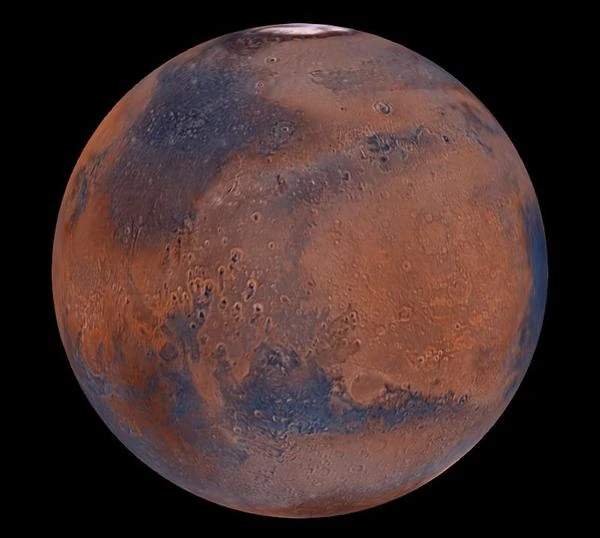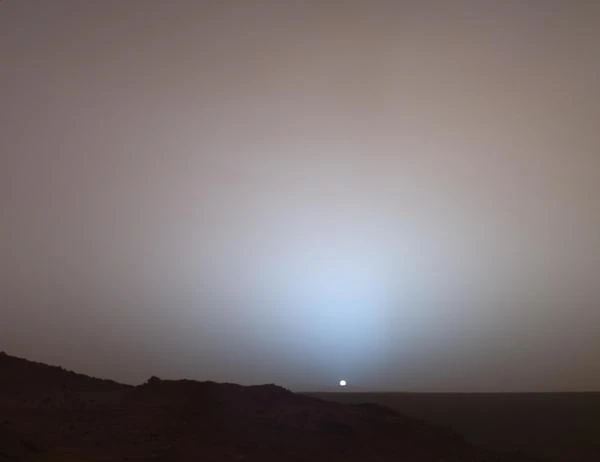
Mars is a fascinating exploration destination and a source of interest in the search for life beyond Earth. Mars is often called "the red planet" due to its distinctive color. The surface of Mars is rich in iron oxide, giving it its characteristic reddish hue.
The planet Mars is home to the tallest volcano in the solar system, Olympus Mons. Olympus Mons rises about 22 kilometers above the average surface level of Mars. It has a diameter of about 600 kilometers, making it also one of the widest volcanoes.
Ascraeus Mons, Pavonis Mons, and Arsia Mons: These three volcanoes are also known as "Tharsis Montes" and are part of the Tharsis volcanic region on Mars. Ascraeus Mons reaches a height of about 18 kilometers, Pavonis Mons reaches about 14 kilometers, and Arsia Mons reaches about 12 kilometers.
Mars also has the largest canyon known in our solar system, Valles Marineris. This canyon system stretches about 4,000 kilometers in length, which is about four times the length of the Grand Canyon on Earth.
Like Earth, Mars has polar ice caps. These polar caps are mainly composed of water ice, but they also contain layers of frozen carbon dioxide, or "dry ice," which undergoes seasonal variations.
The atmosphere of Mars is much thinner than that of Earth, mainly composed of carbon dioxide (CO₂), with small amounts of nitrogen and argon. The atmospheric pressure on Mars is about 0.6% of that on Earth.
Temperatures on the surface of Mars can vary considerably. Maximum temperatures can reach about 20°C at equatorial latitudes during summer, while minimum temperatures can drop to about -140°C.
Robotic missions and observations from Martian orbit have provided compelling evidence of the presence of liquid water in Mars' past. Geological formations such as valleys, riverbeds, and mineral deposits have been interpreted as indicators of a wet past on the planet.
Phobos is the larger of Mars' two moons, with an elongated, irregular shape. It orbits at a distance of about 6,000 kilometers from the planet's surface. Phobos is in synchronous rotation with Mars, meaning it always shows the same face to the planet. This moon is covered in impact craters, testifying to its violent history. Its largest crater is called Stickney. Phobos is one of the closest moons to its parent body in the entire solar system.
Deimos is the smaller of Mars' two moons. It is also an elongated and irregularly shaped moon, but more regular than Phobos. It orbits at a distance of about 23,500 kilometers from the planet's surface. Deimos is also in synchronous rotation with Mars, always showing the same face to the planet. Its surface is dotted with impact craters, but it is less cratered than Phobos.

To go to Mars, you must follow a precise trajectory in space. Scientists use "fuel-efficient" paths called Hohmann transfers, which allow travel with less propulsion. The amount of fuel depends on the mass of the rocket and its departure speed.
A journey to Mars is divided into several stages: lifting off from Earth, setting the right trajectory to Mars, correcting the course en route, entering orbit around Mars or descending directly to the planet, and finally departing for the return. Each stage must be carefully planned and equipped with backup systems in case of problems.
Landing on Mars is very complicated. The atmosphere is very thin: it slows down the rocket but is not sufficient to fully brake with parachutes. Missions therefore use a combination: heat shield to withstand the heat, parachutes to slow down, and engines to land gently.
Astronauts will need to be protected from radiation, breathe air maintained at the right pressure and temperature, and have water and oxygen produced on site. Habitats will be pressurized and modular, and some missions plan to use local resources to produce fuel and water.
Communication with Earth can take from 4 to 24 minutes depending on Mars' position, so astronauts will need to be very autonomous. They will have to manage their survival, movement, and scientific experiments almost alone. The European Space Agency and other agencies (Russia, China, India) are planning robotic missions in the 2020s–2030s, but manned missions to Mars are projected for the 2040–2050 horizon.
| Year | Mission | Country | Agency | Type | Status | Comment |
|---|---|---|---|---|---|---|
| 1960 | 1M No.1 | USSR | OKB-1 | Flyby | ❌ Failure | Lost during launch phase (did not reach orbit). |
| 1960 | 1M No.2 | USSR | OKB-1 | Flyby | ❌ Failure | Lost during launch phase. |
| 1962 | Mars 1 (2MV-4 No.2) | USSR | OKB-1 | Flyby | ❌ Failure | Lost communication en route to Mars. |
| 1964 | Mariner 3 | United States | NASA | Flyby | ❌ Failure | Fairing not separated → mission lost. |
| 1965 | Mariner 4 | United States | NASA | Flyby | ✅ Success | First close-up images of the Martian surface. |
| 1967 | Zond 2 | USSR | Lavochkine | Flyby | ❌ Failure | Lost communication before flyby. |
| 1969 | Mariner 6 | United States | NASA | Flyby | ✅ Success | Imaging and spectroscopy. |
| 1969 | Mariner 7 | United States | NASA | Flyby | ✅ Success | Complement to Mariner 6 observations. |
| 1969 | 2M No.521 (1969A) | USSR | Lavochkine / USSR | Orbiter | ❌ Failure | Launch failure / did not reach orbit. |
| 1969 | 2M No.522 (1969B) | USSR | Lavochkine / USSR | Orbiter | ❌ Failure | Launch failure. |
| 1971 | Mariner 8 | United States | NASA | Orbiter | ❌ Failure | Launch failure (lost in LEO). |
| 1971 | Kosmos 419 (3MS No.170) | USSR | Lavochkine | Orbiter | ❌ Failure | Stage problem → did not leave LEO. |
| 1971 | Mars 2 | USSR | Lavochkine | Orbiter + lander | ⚙️ Partial | Orbiter operational; lander crashed on the surface (impact). |
| 1971 | Mars 3 | USSR | Lavochkine | Orbiter + lander | ⚙️ Partial | Landing initially successful, transmission lost ~20 s after. |
| 1971 | Mariner 9 | United States | NASA | Orbiter | ✅ Success | First Martian orbiter; global mapping. |
| 1973 | Viking 1 | United States | NASA | Orbiter + lander | ✅ Success | Landing and scientific operations (biological research). |
| 1976 | Viking 2 | United States | NASA | Orbiter + lander | ✅ Success | Similar to Viking 1; geological and atmospheric analyses. |
| 1988 | Phobos 1 | USSR | Lavochkine | Orbiter (to Phobos) | ❌ Failure | Remote control error → probe lost en route. |
| 1988 | Phobos 2 | USSR | Lavochkine | Orbiter (to Phobos) | ⚙️ Partial | Successful orbital arrival, then loss of contact before final operations. Partial observations made. |
| 1992 | Mars Observer | United States | NASA | Orbiter | ❌ Failure | Lost contact just before Martian orbit insertion. |
| 1996 | Mars Global Surveyor | United States | NASA | Orbiter | ✅ Success | Detailed mapping of the surface and atmosphere. |
| 1996 | Mars Pathfinder (Sojourner) | United States | NASA | Lander + small rover | ✅ Success | Airbag landing demonstrator + mobile exploration (Sojourner). |
| 1998 | Nozomi | Japan | ISAS / JAXA | Orbiter | ❌ Failure | Trajectory and propulsion problems → did not reach Mars. |
| 1999 | Mars Climate Orbiter | United States | NASA | Orbiter | ❌ Failure | Unit conversion error (imperial/metric) → incorrect trajectory, lost. |
| 1999 | Mars Polar Lander | United States | NASA | Lander | ❌ Failure | Lost during landing; probable cause: premature retro-rocket firing. |
| 1999 | Beagle 2 (additional mention) | UK / Europe | UK/ESA | Lander | ⚙️ Partial | Landing: no initial communication; later found intact (panel/antenna deployment failure). |
| 2001 | Mars Odyssey | United States | NASA | Orbiter | ✅ Success | Long orbital mission for gamma studies, mineralogy, and communication relay. |
| 2003 | Mars Express | Europe | ESA | Orbiter | ✅ Success | Geological and atmospheric observation; extended mission. |
| 2003 | Beagle 2 | UK / Europe | UK/ESA | Lander | ⚙️ Partial | Landed intact but did not communicate (antenna deployment failure); later found on the surface. |
| 2003 | Spirit (MER-A) | United States | NASA | Rover | ✅ Success | Long-duration exploration (2004–2010); discovered evidence of ancient water. |
| 2003 | Opportunity (MER-B) | United States | NASA | Rover | ✅ Success | Operated 2004–2018; discovered aqueous formations. |
| 2005 | Mars Reconnaissance Orbiter (MRO) | United States | NASA | Orbiter | ✅ Success | High-resolution imaging and telecom relay; detailed observations. |
| 2007 | Phoenix | United States | NASA | Lander | ✅ Success | Study of permafrost in the northern polar region; identification of water ice. |
| 2011 | Fobos-Grunt (+ Yinghuo-1) | Russia / China | Roscosmos / CNSA | Sample return / orbiter | ❌ Failure | Stuck in Earth orbit after launch; premature re-entry. |
| 2011 | Curiosity (MSL) | United States | NASA / JPL | Rover | ✅ Success | Analysis of Gale Crater; detection of clement environments and organic compounds. |
| 2013 | Mangalyaan (Mars Orbiter Mission) | India | ISRO | Orbiter | ✅ Success | First Indian success to Mars; scientific and technological orbiter. |
| 2013 | MAVEN | United States | NASA | Orbiter | ✅ Success | Study of the upper atmosphere and atmospheric losses over time. |
| 2016 | ExoMars Trace Gas Orbiter (TGO) | Europe / Russia | ESA / Roscosmos | Orbiter | ✅ Success | Studies trace gases (e.g., methane) and serves as a relay. |
| 2016 | Schiaparelli EDM | Europe | ESA | Lander demonstrator | ❌ Failure | Impact on the ground: altimetric measurement error and poorly timed retro-rocket deployment. |
| 2018 | InSight | United States | NASA | Lander | ✅ Success | Seismic measurements and study of the internal structure of Mars. |
| 2020 | Hope (Al-Amal) | United Arab Emirates | MBRSC / UAESA | Orbiter | ✅ Success | Global climate study and atmospheric profiles. |
| 2020 | Tianwen-1 | China | CNSA | Orbiter + lander + rover | ✅ Success | First complete Chinese success; Zhurong rover operated on the surface. |
| 2020 | Perseverance (Mars 2020) | United States | NASA / JPL | Rover | ✅ Success | Sample collection (caches) for future return; Ingenuity demonstration. |
| 2021 | Zhurong (deployed from Tianwen-1) | China | CNSA | Rover | ✅ Success (then inactive) | Exploration of Utopia Planitia region; prolonged inactivity declared in 2022. |
| 2021 | Ingenuity | United States | NASA | Helicopter | ✅ Success | First powered, controlled flight in the atmosphere of another planet (March). |
| 2024 | ESCAPADE (planned) | United States | NASA / APL | Dual orbiter (planned study mission) | In preparation | Mission planned to study Mars in support of future campaigns (2024–2025 window according to planning). |
| N.B.: This table (non-exhaustive) covers the main historical missions, successful and failed, as well as notable attempts up to 2025. It includes launch attempts, orbiters, landers, rovers, and missions targeting Phobos/Deimos. | ||||||